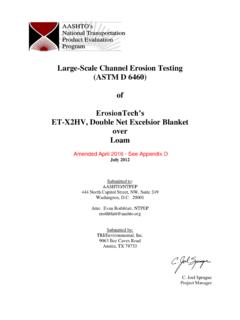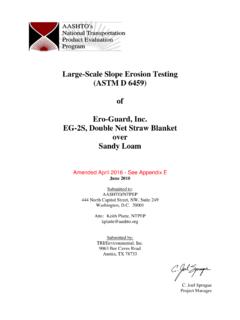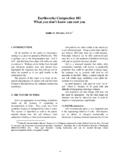Transcription of Large-Scale Slope Erosion Testing (ASTM D 6459 modified ...
1 Large-Scale Slope Erosion Testing ( astm D 6459 modified ) of GeoSkin XT over Sandy Loam August 2011 Submitted to: AASHTO/NTPEP 444 North Capitol Street, NW, Suite 249 Washington, 20001 Attn: Evan Rothblatt, NTPEP Submitted by: TRI/Environmental, Inc. 9063 Bee Caves Road Austin, TX 78733 C. Joel Sprague Project Manager August 19, 2011 Mr. Evan Rothblatt AASHTO/NTPEP 444 North Capitol Street, NW, Suite 249 Washington, 20001 E-mail: Subject: Large-Scale Slope Testing of GeoSkin XT over Sandy Loam Dear Mr. Rothblatt: This letter report presents the results for Large-Scale Slope Erosion tests performed on GeoSkin XT hydraulically-applied Erosion control product (HECP) over sandy loam. All Testing work was performed in general accordance with the astm D 6459, Standard Test Method for Determination of Rolled Erosion Control Product (RECP) Performance in Protecting Hillslopes from Rainfall-Induced Erosion modified as necessary to accommodate hydraulically-applied mulch.
2 The product was allowed to cure on the slopes for approximately 48 hours prior to Testing . Generated results were used to develop the following general cover factor (C-Factor) for the tested material: C-Factor GeoSkin XT @ 2000lbs/acre = for cumulative R Factor < 231 Eqn: C = TRI is pleased to present this final report. Please feel free to call if we can answer any questions or provide any additional information. Sincerely, C. Joel Sprague, Senior Engineer Geosynthetics Services Division Cc: Sam Allen, Jarrett Nelson - TRI GeoSkin XT HECP over Sandy Loam Slope Erosion Testing for NTPEP August 19, 2011 2 Slope Testing REPORT GeoSkin XT HECP over Sandy Loam Testing EQUIPMENT AND PROCEDURES Overview of Test and Apparatus TRI/Environmental, Inc.'s (TRI's) Large-Scale Slope Erosion Testing facility is located at the Denver Downs Research Farm in Anderson, SC. Testing oversight is provided by C. Joel Sprague, The Large-Scale Testing reported herein was performed in accordance with astm D 6459 modified as necessary to accommodate hydraulically-applied mulch, on 3:1 slopes using loamy soil test plots measuring 40 ft long x 8 ft wide.
3 The simulated rainfall was produced by ten rain trees arranged around the perimeter of each test Slope . Each rain tree has four sprinkler heads atop a 15 ft riser pipe. The rainfall system has been calibrated prior to Testing to determine the number of sprinkler heads and associated pressure settings necessary to achieve target rainfall intensities and drop sizes. The target rainfall intensities are 2, 4, and 6 in/hr and are applied in sequence for 20 minutes each. Three replicate test slopes covered by the same hydraulically-applied Erosion control product (HECP) submitted were tested. The application rate of the HECP was 2000 lb/acre. The product was allowed to cure on the slopes for approximately 48 hours prior to Testing . The Erosion resistance provided by the product tested is obtained by comparing the protected Slope results to control (bare soil) results. Tables and graphs of rainfall versus soil loss are generated from the accumulated data.
4 Hydraulic Erosion Control Product (HECP) The following information and index properties were determined from the supplied products. Table 1. Tested Product Information & Index Properties Product Information and Index Property / Test Units Sampled Product Product Identification - GeoSkin XT Manufacturing Plant Location - Centre, AL Lot number of sample - 2 Bags: lot 1A-4-27-11; 2 Bags: lot A-4-28-11; 1 Bag: lot 2A-4-26-11 Mechanically Processed Straw % 73% 3% Mechanically Processed Reclaimed Cottom Plant Material % 14% 3% Proprietary Blend of Tackifiers, Activitors and Additives % < 1% Moisture % 12% 3% Tensile Strength ( astm D 6818 modified )* lb/in N/A Tensile Elongation ( astm D 6818 modified )* % N/A Thickness ( astm 6525 modified )* mils 136 Light Penetration ( astm 6567 modified )* % cover Water Absorption ( astm 1117 / ECTC TASC 00197)* % Wt Change N/A Mass / Unit Area ( astm D 6566 modified )* osy Note: Index specimens were made using the currently proposed astm procedure.
5 N/A = not applicable because suitable specimens could not be made using the currently proposed astm procedure. * Values from Independent Testing of Randomly Sampled Product GeoSkin XT HECP over Sandy Loam Slope Erosion Testing for NTPEP August 19, 2011 3 Test Soil The test soil used in the test plots had the following characteristics. Table 2. TRI-Loam Characteristics Soil Characteristic Test Method Value % Gravel astm D 422 0 % Sand 45 % Silt 35 % Clay 20 Liquid Limit, % astm D 4318 41 Plasticity Index, % 8 Soil Classification USDA Sandy Loam Soil Classification USCS Sandy silty clay (ML-CL) K-Factor D 6459 Preparation of the Test Slopes The initial Slope soil veneer (12-inch thick minimum) is placed and compacted. Compaction is verified to be 90% ( 3%) of Proctor Standard density using astm D 1556 (sand cone method). Subsequently, the test slopes undergo a standard preparation procedure prior to each Slope test. First, any rills or depressions resulting from previous Testing are filled in with test soil and subject to heavy compaction.
6 The entire test plot is then tilled to a depth not less than four inches. The test Slope is then raked to create a Slope that is smooth both side-to-side and top-to-bottom. Finally, a steel drum roller is rolled down-and-up the Slope 3 times proceeding from one side of the plot to the other. The submitted Erosion control product is then installed using the spray technique acceptable to the client. For this Testing , TRI applied the product to the slopes. Installation of Erosion Control Product on Test Slopes As noted, the submitted Erosion control product was installed as directed by the client. For the tests reported herein, the GeoSkin XT was applied at the rate of 2000 lb/acre. The applied material was allowed to cure for approximately more than 48 hours prior to Testing . Specific Test Procedure Immediately prior to Testing , rain gauges are placed at the quarter points ( 10, 20, 30 ft) on the Slope . The Slope is then exposed to sequential 20-minute rainfalls having target intensities of 2, 4, and 6 inches per hour.
7 All runoff is collected during the Testing . Additionally, periodic sediment concentration grab samples are taken and runoff rate measurements are made. Between rainfall intensities, the rainfall is stopped and rainfall depth is read in the three rain gauges, valves are adjusted to facilitate the subsequent rainfall intensity, and empty collection vessels are positioned to collect subsequent runoff. GeoSkin XT HECP over Sandy Loam Slope Erosion Testing for NTPEP August 19, 2011 4 After allowing for sediments to settle, water is decanted from the collected runoff. The remaining solids are used to determine bulk soil loss. Bulk soil loss is measured by drying all collected sediments. Figure 1. Rainfall Testing Facility (set up for a control run) Figure 2. Typical Sampling Figure 3. Typical Control Result Pictures of Slope preparation are shown in Figure 4. Figure 4. Typical Prepared Soil Slope & HECP Application GeoSkin XT HECP over Sandy Loam Slope Erosion Testing for NTPEP August 19, 2011 5 Pictures of the eroded slopes are shown in Figures 5 thru 7.
8 Figure 5a. Test Slope #1 Cured Slope Figure 5c. Test Slope #1 At End of 6 in/hr Event Figure 5b. Test Slope #1 At the End of 4 in/hr Event Figure 5d. Test Slope #1 At End of 6 in/hr Event Figure 6a. Test Slope #2 Cured Slope Figure 6b. Test Slope #2 At End of 2 in/hr Event GeoSkin XT HECP over Sandy Loam Slope Erosion Testing for NTPEP August 19, 2011 6 Figure 6c. Test Slope #2 End of 6 in/hr Event Figure 6d. Test Slope #2 6 in/hr Event Rainfall Figure 7a. Test Slope #3 Cured Slope Figure 7b. Test Slope #3 End of 4 in/hr Event Figure 7c. Test Slope #3 End of 6 in/hr Event Figure 7d. Test Slope #3 Close-up After the 6 in/hr Event GeoSkin XT HECP over Sandy Loam Slope Erosion Testing for NTPEP August 19, 2011 7 TEST RESULTS The Cover Management (C) Factor from the Revised Universal Soil Loss Equation (RUSLE) of the USDA-ARS Agricultural handbook 703 is the reported performance measure for slopes determined from this Testing .
9 The C-Factor and R-Factor reported herein are related through RUSLE by the following relationship: A = R x K x LS x C x P where: A = the computed soil loss in tons per acre (measured/calculated from test); R = the rainfall Erosion index (measured/calculated from test); K = the erodibility of the soil (calculated from test see Figure 9); LS = the topographic factor ( for 8 x 40 ft Slope ); C = the cover factor = ratio of protect soil loss to control soil loss ( for control); and P = the practice factor ( for all test slopes). Total soil loss and the associated rainfall depth measured during the Testing are the principle data used to determine the C Factor. The cumulative C-Factors shown in Table 3 are the ratio of the soil loss from the protected condition at a calculated cumulative R-Factor divided by the cumulative soil loss from the control plot (Figure 9) at that same R-Factor. In all cases, the soil loss and associated rainfall data for both protected and control conditions are used to develop a normalized cumulative graph of R-Factor versus C-Factor (R factor = total kinetic energy of the storm (E) times its maximum 30-minute Intensity (I)).
10 The maximum average normalized cumulative R-Factor calculated for the target test events: 2 in/hr for 20 minutes + 4 in/hr for 20 minutes + 6 in/hr for 20 minutes, is R = 231. The C-Factor associated with this normalized maximum average result is the reported performance value. This facilitates product-to-product comparison of test results at a common point of the storm event. Graphs of R-Factor versus C-Factor for the protected condition and Soil Loss versus R-Factor for the control condition are shown in Figures 8 and 9, respectively. Figure 8 includes the best regression line fit to the test data to facilitate the determination of the C-factor. Figure 8 additionally allows users of this report to evaluate performance at other points in the model storm by selecting the R factor (and the corresponding C Factor) that may fit local conditions. According to the test procedure astm D6459, a test may be stopped in the event of catastrophic soil loss, as determined by the lab.









